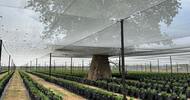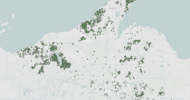Barron's | 8 January 2011
By LESLIE P. NORTON
The global boom in commodities has raised the profile of three Asian agribusinesses listed in Singapore. The trio compete with long-established Western behemoths like publicly traded Archer Daniels Midland and Bunge, and privately held Cargill and Louis Dreyfus—a group that includes the world's largest grain, cotton and rice traders.
The four Western companies—often referred to by their initials, ABCD—are being tailed by Olam International, Wilmar International, and NobleGroup.
Noble, Olam and Wilmar have been operating under most U.S. investors' radar for several years, but don't expect that to remain the case. Thanks to a confluence of factors—they're based in Asia, at the intersection of the world's largest populations, amid countries eager to secure stable food supplies—the outlook for the three looks rich. Their cash flow has been growing smartly, at a percentage increase in the upper teens. And while Noble and Olam, in the past, were best known as trading companies, they have moved into production, snapping up plantations and other assets. Recently, Olam weighed merging with Louis Dreyfus, which would have moved it to the top ranks of global agribusiness.
The three "are expanding their asset strategy pretty fast. In five years, they will be much more similar to the giants," says Tanuj Shori, who follows the companies in Singapore for Nomura International.
Adds Andrew Foster, portfolio manager at Matthews International Capital Management in San Francisco: "This is definitely a category that investors should be watching and have an opinion about. To ignore them altogether is not sound."
Thanks to their long history in trading, the companies generally can accurately judge when assets are cheap, when to trim production and how to wring the most profit from a crop. For example, they know when to use sugar cane mainly to produce ethanol and when to use it to make sugar. Says Ricardo Leiman, Noble Group's chief executive, "We can see the global bottlenecks."
Prices of soft commodities—a group that primarily includes coffee, cocoa and sugar, but also extends to cotton and grains—have been jumping lately, not least because of 2010's string of droughts in Russia, floods in Pakistan, mudslides in central China and bushfires in Australia. After such a tough year, Bunge's chief, Alberto Weisser, suggested recently that he expects prices to normalize in 2011. (In fact, earnings for the three will be a mixed bag this year because of weak oilseed-crushing margins and weak industrial demand, among other things.) Yet, long-term, prices are probably headed higher. Olam figures the global population expands by at least 75 million each year. All those people need to be fed. Meanwhile, per-capita income is rising, and people in emerging countries are eating more protein and less cereal. This collides with a decline in arable land, caused by rising urban populations. "Farms are literally being transformed into parking lots as Chinese car ownership increases," observes Sunny Verghese, Olam's chief. "There will be more episodes of droughts and floods over the net 25 years, and we will see a significant supply-demand imbalance."
Companies that can provide safe products, with traceable sources, are likely to experience rising demand. (One area of growing popularity: organic and "fair-trade" sourcing. The latter term refers to food produced with labor forces deemed to have been treated fairly.)
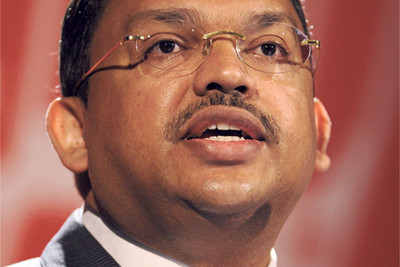
Olam CEO Sunny Verghese. Olam bought a distressed Australian almond farm that made it one of the world's largest almond producers and provided it with extensive water rights.
THE LONG-TERM trends make Olam very appetizing. It's the world's biggest supplier of cashews and sesame seeds, and among the biggest sources of cocoa, rice, peanuts and cotton. It operates in 64 countries, with 10,000 customers and more than 20 products. In fact, if you've ever eaten Costco cashews, Hershey's chocolate or Planter's peanuts, you've probably had a taste of Olam's potential.
Under Verghese, Olam originally exported cashews from Nigeria, then used the supply chain to bring sugar and rice from Asia into Africa. One big strength of the company is its personnel. It recruits managers from regional business schools, then assigns them to build relationships with farmers, monitor the agricultural scene at far-flung locations and gather intelligence.
Lately, as it dominated its product niches, Olam began acquiring upstream and midstream production and processing facilities, as part of Verghese's plan to double shareholder value. In the past three years, it has acquired 17 companies. Olam bought a distressed Australian almond farm, for example, that made it one of the world's largest almond producers and provided it with extensive water rights. It's also expanding into commodity financial services. Verghese is also boosting the company's already large presence on Africa. Recently, as Gabon announced its 50th year of independence, Olam said that it would invest in a fertilizer facility and a palm plantation there. Nomura thinks the Gabon properties could contribute 15% of Olam's cash flow by 2015.
Last fall, Olam said it had talked with 159-year-old Louis Dreyfus about a combination some speculated would involve a reverse merger for the bigger, private company. Both sides have stayed mum since then, and analysts doubt a marriage will occur. But the incident highlighted Verghese's ambitions.
Olam went public in Singapore in 2005. Since then, its stock is up 419%. It will probably earn S$287 million, or 14 Singapore cents a share, in the year ending June; that is expected to rise to S$364 million or 17 Singapore cents, in fiscal 2012. At the current price, it has a market value of S$6.8 billion. (There are 1.29 Singapore dollars to each U.S. dollar.) One risk is dilution. Olam is acquisitive, so it eventually may use an equity offering to fund its expansion. Still, Temasek, one of Singapore's sovereign wealth funds, is a fan.
So are some U.S.-registered mutual funds, which offer Americans an easy way to invest in the three companies. In multiple portfolios, BlackRock, Hartford, Prudential, Vanguard and Fidelity hold Olam or Noble; Fidelity, UBS and Prudential have somewhat smaller holdings of Wilmar.
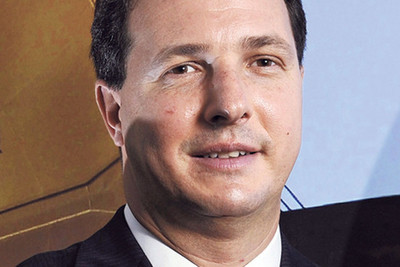
Noble's CEO Ricardo Leiman. Noble, part-owned by China's sovereign wealth fund, owns oil palm plantations in Africa and Asia.
NOBLE GROUP, WITH ITS HEADQUARTERS in Hong Kong, is Asia's biggest supplier of raw materials. Just 22% of its revenue comes from agriculture; the rest is derived from materials like iron ore. Noble has invested heavily in mines and processing. It's also in shipping and logistics and energy sales; it owns bulk carriers. And it recently purchased Sempra Energy Solutions, a North American electricity retailer that operates in 16 U.S. states. The seller was a joint venture owned by Sempra and Royal Bank of Scotland. SES is expected to account for 13% of Noble's 2011 earnings.
Noble was founded by former Philipp Brothers' Asia chief Richard Elman in 1987; the British-born Elman, who famously flunked out of high school, named his firm after Noble House, the fictional Hong Kong trading titan imagined by British novelist James Clavell. Elman hired Ricardo Leiman from Louis Dreyfus in 2006 as chief operating officer; last year, Leiman became CEO.
For all of Noble's strength in hard assets, agriculture is a fast-growing focus for the company. Agriculture accounts for less than a quarter of its revenue but 38% of its gross profit. In 2009, China Investment, Beijing's sovereign wealth fund, took a 15% stake in Noble. The Chinese also plan to make joint investments with the company. Noble already processes oilseeds and owns palm plantations and other ag assets. Last month, it bought two sugar mills from Brazilian ethanol producer Grupo Cerradinho. Agriculture can be a high-margin business. HSBC reckons that an increase of just a 10th of a percentage point in agricultural margins boosts Noble's earnings 1.3%.
Since it went public in March 1997, shares of Noble have risen 150%, to a recent S$2.20. The company's stock-market value is about S$13.7 billion.
The Bottom Line
Three Asian companies have become global forces in the business of producing, processing and distributing agricultural commodities. And their stocks look like buys for the long haul.
In 2010, however, Noble's profit probably fell to US$504 million, or eight cents a share, partly because of pressure on soybean-crushing margins. But earnings have grown at a fast clip over the past few years, and are likely to spring more than 50% this year. Says Noble's Ricardo Leiman: "Noble is a growth story. We intend to get to $1 billion in earnings in 2013. We want to grow the top and bottom line 20%. We pay a 25% dividend every year."
Noble has long traded at a discount to Olam and ADM because of its exposure to cyclical commodities. Morgan Stanley figures that multiple will rise as Noble increases its earnings 30% annually over the next three years. In fact, Nomura thinks the stock is worth S$2.52—10% over last week's price.
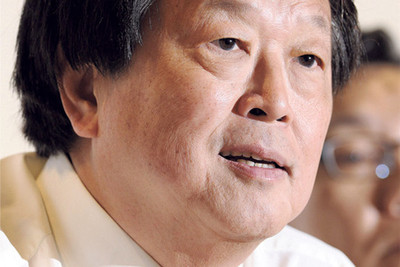
Wilmar CEO Kuok Khoon Hong. Wilmar owns vast rubber, sugar and oil palm estates across Asia and Africa as well.
SINGAPORE-BASED WILMAR is Asia's leading agribusiness group and the world's largest integrated palm-oil company, with a huge market value of S$35.6 billion. Demand is expected to grow swiftly because of demand for biofuels. That's part of the reason Wilmar bought the sugar and renewable-energy businesses of Australia's CSR. Wilmar also has a joint venture in Africa with Olam to invest in palm and rubber assets. Also, a huge presence in China generates half the company's revenue, and it has weighed listing its China unit in Hong Kong.
One fan is Anthony Cragg of Wells Fargo Advantage Asia Pacific Fund. He says Wilmar "is a long-term core holding, given the growth of agribusiness in China, India, and Indonesia." Another fan is ADM, which owns 5% of Wilmar's shares.
Wilmar trades at 19 times earnings. Its profits for the year just ended are probably $1.54 billion, or 25 cents a share, and they should rise to $2.1 billion, or 33 cents, in the current year, according to Goldman Sachs.
For sure, these stocks are volatile, have lots of moving parts and can be opaque. But the companies are run by some of Asia's canniest traders, and crops aren't all they're good at growing.



